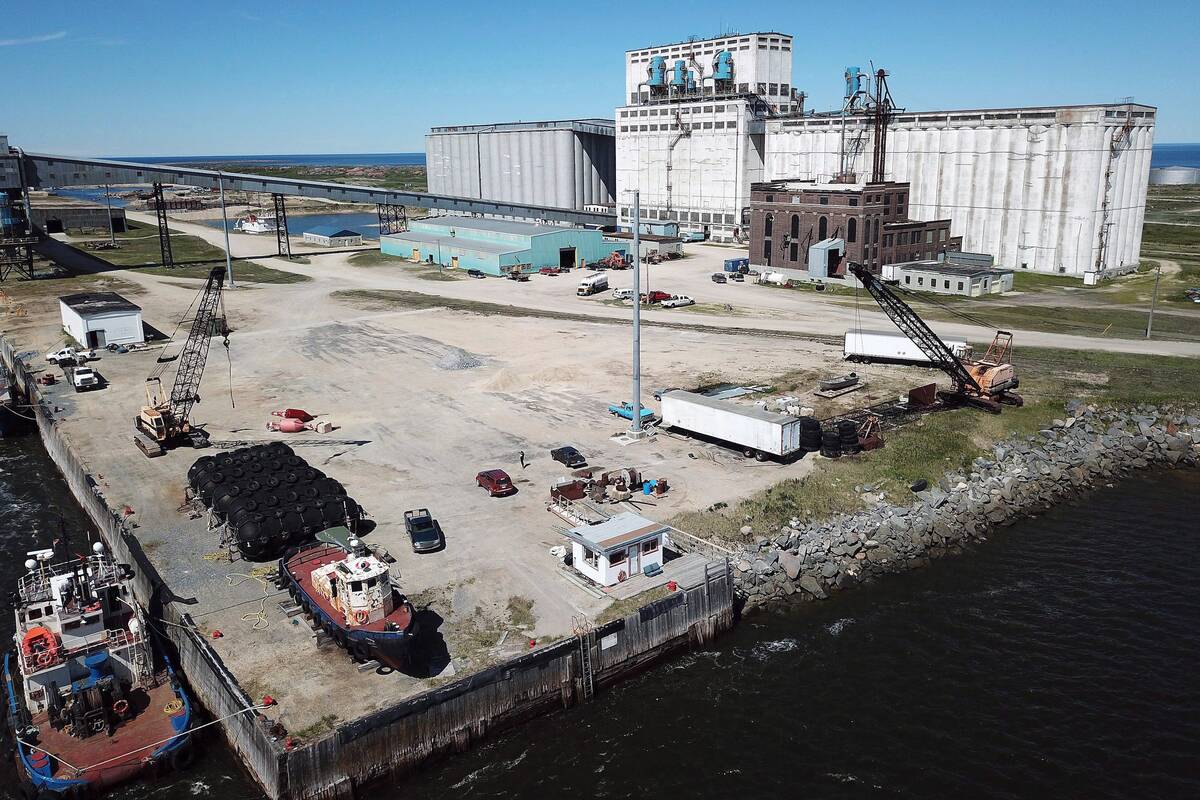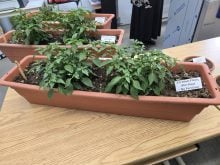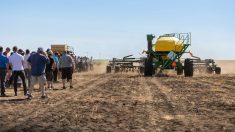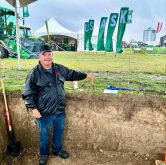There’s time to till this fall, but that doesn’t mean you necessarily should.
That’s the message from Manitoba’s soil specialists, as harvest wraps up on a tremendously dry year — one they worry will end even drier if some of that precious water is lost through weed uptake or extra movement of soil.
Why it matters: Periodic tillage takes more planning, but experts say that the benefits may be well worth the effort, compared to just hitching up to the deep tiller as a matter of course.
Read Also

Sizing up Port of Churchill expansion challenges
The Port of Churchill has some hurdles to clear before it can become the sea trade powerhouse for Manitoba and Canada that governments and the agricultural industry hope it will.
Data from the province’s ag weather network suggests that Manitoba is a full year behind its normal precipitation. Or, put another way, one whole crop’s worth of water. That data puts available water holding capacity in the top four feet of the soil anywhere from 20 to 50 per cent, with areas of the west faring a bit better.
Provincial staff estimate next year’s crop moisture will be starting in the red by potentially 10 to 12 inches of water, with much lower moisture reserves at depth than typical.
Given that, provincial soil specialist Marla Riekman says she is surprised about how much tillage she’s seen this fall.
In a province that has made international headlines for serious drought, most were expecting producers to avoid disturbing the soil and losing precious water reserve.
“I think, a lot of times, for some people there’s a bit of a fear of the idea of not tilling,” she said, citing reasons like preparing the seedbed or uncertainty around running a seeder through residue, if reduced tillage is not typically the operator’s production method of choice.
Preferred crops, which may come with more complicated residue management, in areas like the Red River Valley may also play in, she added.
“Part of it too could be the fact that, while we are in a dry spell, a lot of Manitoba doesn’t experience dry to this level or this degree and we’re so used to having moisture, especially in spring,” Riekman also said.
In places like the heavy clay of the Red River Valley, that often tips the scales in favour of fall tillage, since a pre-seed tillage pass may not always be possible.
At the same time, snowy ditches blackened with “snirt” during the winter have been a starkly visible impact of wind erosion in recent years, something experts like Riekman and Agriculture and Agri-Food Canada agrologist Curtis Cavers warn are encouraged by that same fall tillage.
“If we have a dry spring and we’ve prepped (the field) now — lost moisture, not holding that extra moisture into next spring — we also have an overly tilled field that is at high risk in those dry conditions of having soil blowing, that type of thing,” she said. “That might not be the best position to be in either.”
Riekman also pointed to sandblasting damage, which caused several reseed claims to be filed this year.
For his part, Cavers can see two main exceptions where a case for tillage could be made. In one case, the dry conditions may actually be conducive to subsoiling compacted areas, he said.
The other complicating factor is weeds.
“Especially if we’re concerned about herbicide resistance,” Cavers said.
While tillage may dry soil, so too do the weeds, taking up moisture and nutrients.
Kim Brown-Livingston, provincial weed specialist, has argued that fall weed control might be particularly critical this year, including annual weeds that are typically left to winterkill.
She did, however, urge producers to avoid tilling kochia patches at all costs, since those areas often have a salinity issue.
“That’s the worst thing I think you could be doing to manage your kochia,” she said.
The weed specialist urged producers to spray when possible, maintain moisture and, if tillage is needed, to try and hold off until spring.
“Tillage, if you need to do it, think about how you’re doing it,” Cavers said. “I’m not judging. I’m not trying to make it all black and white or anything like that. But if you can eliminate it, that’s probably a really good thing.”
The case for reducing tillage
Like many soil scientists, neither Riekman nor Cavers are huge fans of tillage.
Cavers argued that tillage can remove a half-inch of water in the soil per pass while also oxidizing soil organic matter, causing loss. At the same time, he noted, tillage often drops soil cover below critical levels. High-speed tillage that throws dirt helps strip topsoil off higher elevations of the field — referred to as tillage erosion.
Reducing tillage, along with increasing soil organic matter, are among the basic lessons that Cavers hoped to convey during a soil and water management webinar put on by the provincial government in early October.
A one per cent increase in soil organic matter is associated with up to 36 per cent jump in yield, the soil scientist argued.
“It’s reconstructing the sponge, so to speak,” Cavers said. “Rebuilding your organic matter, improving your structure. It’s kind of a hard thing in some ways to do this, because we’re saying, do this by not doing something else.”
This year, in particular, producers will also want to trap every bit of snow on the field that they can.
“If you can trap it and keep it where you need it, we know the soil’s dry. We know that it will soak in if there’s infiltration ability… but you’ve got to set it up so it can rather than just blow off,” Cavers said.
Middle ground
For some people, tillage is a dirty word. For others, it’s a significant part of production practices.
Riekman, meanwhile, says it’s complicated, even in a drought year like Manitoba is currently experiencing. Both Cavers and Riekman urged farmers to be strategic with their tillage, not just this year, but as a matter of course.
For Riekman, the immediate question becomes about how much tillage reduction the producer can realistically commit to.
“You don’t have to commit to zero till if you’re not ready to commit to zero till, but it’s baby steps,” she said.
If there is periodic tillage, there should also be periodic rest from tillage, she said. She urged producers to examine their rotations to identify windows for those rests.
“You can also start looking at that rotation and saying, OK, I know I’m dealing with ‘x’ residue, and I also need ‘x’ for a seedbed to prep for the next crop following it, what is the most appropriate tillage decision in that case?” she said.
“It takes a lot of planning to look at it from that perspective, essentially,” she said. “But by having that option and that opportunity to look at that kind of perspective, it may actually be beneficial in the long run because you might actually be able to plan your tillage where it is essentially most needed.”
Riekman cited one scenario where the producer might find rotational, occasional tillage is the best way to bury stratified phosphorus and decrease phosphorus loss.
As a tool, Cavers argued that tillage is “value neutral,” and no one tillage plan will fit every operation
The premise of strategic tillage also pushes back against the idea of one tool for all jobs, Riekman said. For cutting up residue, true vertical tillage certainly does the work, but while an excellent tool for residue management, vertical tillage is less than optimal for soil management.
Still, she noted, low-disturbance, true vertical tillage may be one way to deal with difficult residue like soybean. High-disturbance discs, meanwhile are hard on soil structure, Riekman said.
“Everybody loves the vertical till unit, because it fluffs everything up and leaves it nice and smooth on the surface, and it leaves a nice pack down two inches, so you’ve got something firm to place the seed into,” she said. “The problem is you’ve got this potential for compaction showing up at two inches where we’re overusing this type of equipment.”
Strategic tillage, on the other hand, should include how different tillage implements on the farm can be mixed and matched to best fit within the system, webinar attendees heard.
Long term
Regardless of tillage choices, those choices won’t solve Manitoba’s dry soil problem. Any producer working to build soil organic matter can likely testify on how long it took to start seeing improvement.
Instead, experts like Cavers and Riekman are looking more in the long term, urging producers to look at reduced and strategic tillage to buffer against similar years down the road.
For this year, it’s all about mitigating damage as much as possible for the spring crop to come.
“We have no idea what’s coming,” Riekman said. “We could have this beautiful year next year with the perfect amount of timely rains as we need it and we could just have a bumper crop. But we don’t know. What we do know right now is our soils are dry. We don’t have that stored soil moisture that we normally would have in the fall, and we’re just trying to figure out how we can plan for kind of a worst-case scenario.”
















